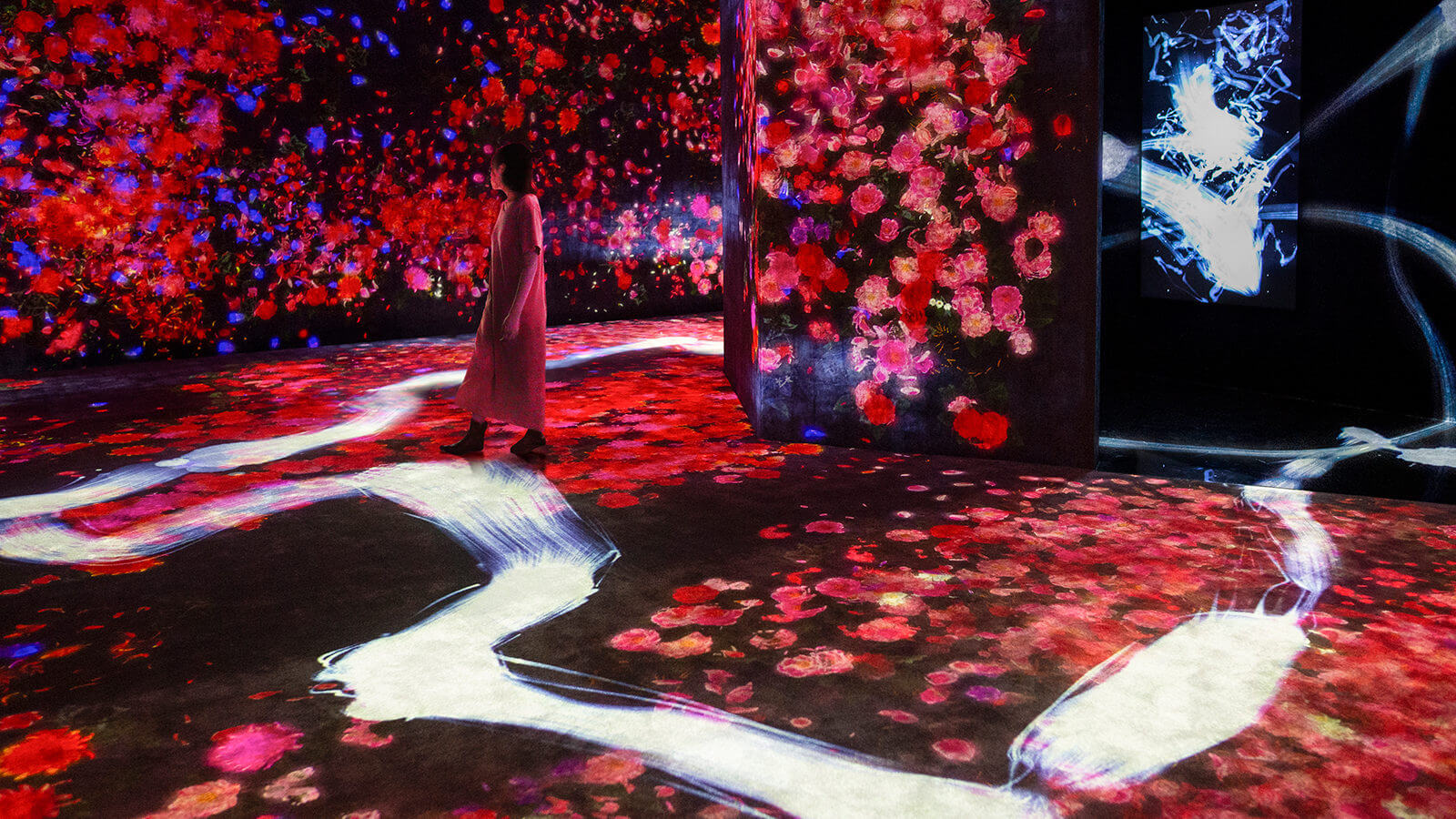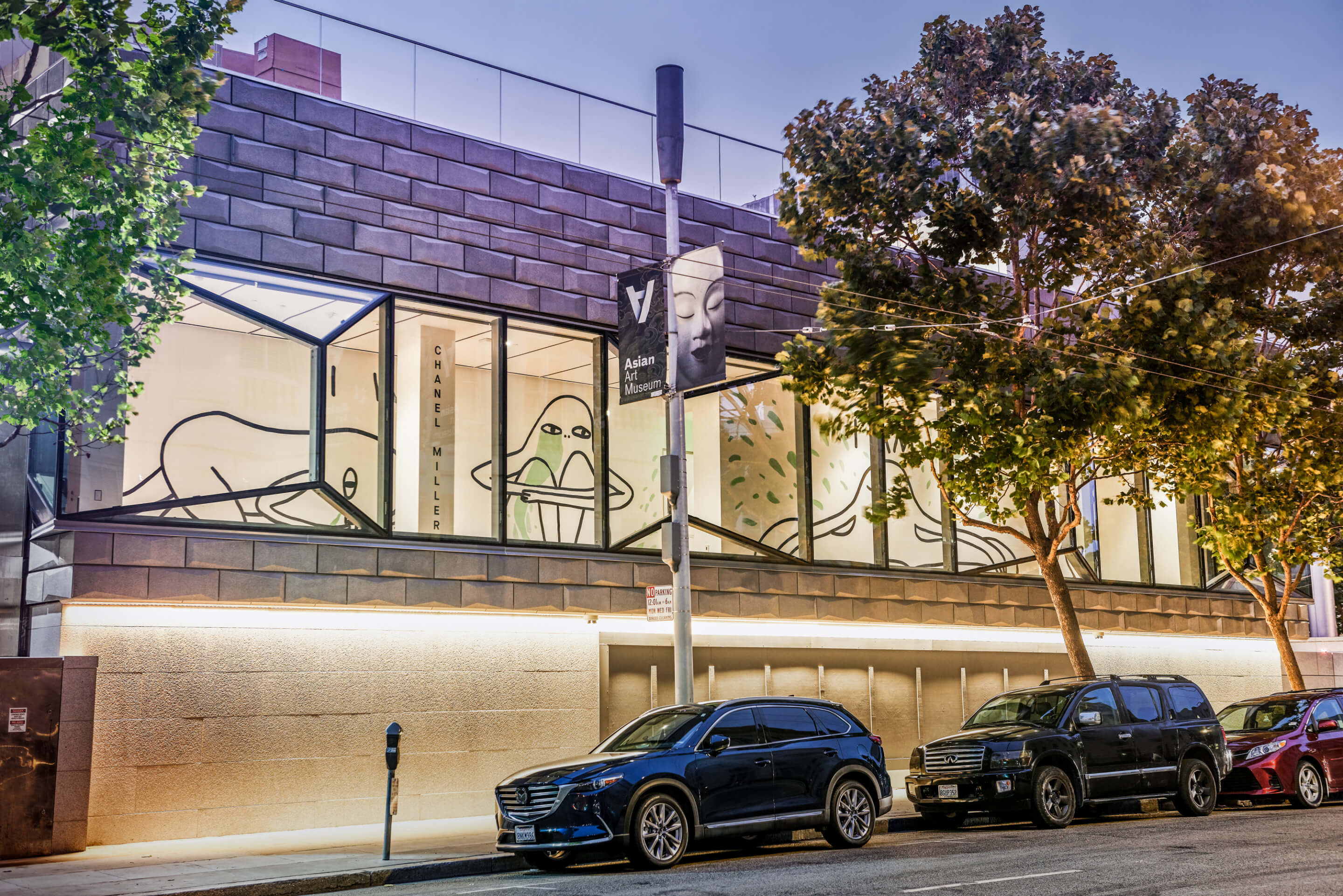Continuity is the kind of art exhibition that gets better with large crowds, mainly because it’s interactive. As visitors make their way through a maze-like darkroom, they are chased by motion-sensitive projections of crows, flower petals, and butterflies. Kanji symbols trickle down from ceilings that appear to rotate, transforming into flames and thunder when you touch them. Somewhere, a speaker plays what sounds like alpha waves, and the air faintly smells of rosewater.
Not only does Continuity mark Tokyo-based art collective teamLab’s first solo show in the United States, it’s also the first exhibition to be held at the Asian Art Museum’s Akiko Yamazaki and Jerry Yang Pavilion, a newly constructed 8,500-square-foot gallery space in San Francisco designed by celebrated Thai architect Kulapat Yantrasast of wHY. Yantrasast was asked to create a pavilion that would be able to house large, uninterrupted installations, and teamLab’s Continuity fit the end result like Cinderella’s foot in her glass slipper.
The main building that now houses the Asian Art Museum used to serve as a San Francisco public library, and though it was heavily renovated by the Italian architect Gae Aulenti in 2003, the skeletal blueprint never really changed. “There remain lots of skinny, fragmented corridors that were meant to store books, not art,” Yantrasast, listing some of the ‘acupuncture points’ he wanted to address in his design, explained over Zoom. There weren’t enough big, column-free spaces that allowed the artwork to breathe.
Another acupuncture point had to deal with interior design. For decades, the basic look and feel of museums and galleries rarely went beyond what Yantrasast called the “White Cube:” a space deliberately robbed of all personality so visitors can fully devote themselves to the art. Not fair, if you ask Kulapat. “Space has its own movement and character,” he professed. “It can never function as a perfectly neutral backdrop. Architecture holds power over other artforms, but it should be a generous kind of power.”

Construction of what would become the Asian Art Museum’s largest exhibition space to date finished in March 2020, but the Pavilion’s actual opening had to be postponed due the pandemic. A spacious terrace housing a sculpture from Ai Weiwei is being built and will start hosting cocktails parties and fundraising events this fall. Below, a rectangular building whose metallic shell kind of resembles terracotta tiles now serves as a kindly host to what may well be teamLab’s most ambitious creation yet.
Speaking of, visitors enter Continuity through a pitch-black showroom. Around the corner, they leave the real world behind and enter an imaginary space of overlapping rooms covered with luminescent projections. Some, like the sunflowers, are stationary. Others, like a flock of crows that fly across the entire exhibition, are not. Each projection responds to the visitor’s presence. The crows burst into a thousand colors when they fly into someone. Butterflies die at the slightest touch, their brittle wings drifting downward as a new projection lights up to take its place.
From temples to theme parks
In a world dominated by science, Continuity is as close to a magical experience as you can get. The exhibition, which will remain open to the public until February 2022, is the result of hundreds of creatives combining their knowledge of media and technology to create a whole new reality. But shows like Continuity don’t exist inside a vacuum, even if it seems like they do. The illusion take place inside a specifically designed space and art and architecture must be completely in sync for the trick to work.
Yantrasast’s design anticipates a future in which an increasing number of contemporary Asian and Asian American artists—from Ai Weiwei to Zheng Chongbin and Lam Tung Pang—will favor working with expansive multimedia installations over more traditional exhibitions. Case in point, Continuity makes full use of the new pavilions, creating an immersive experience that doesn’t just live on walls but instead envelops all three dimensions.
As a collective, teamLab wants people to question the relationship between themselves and the space in which they exist. Inspired by the use of multiple viewpoints in premodern Japanese painting, the projections in Continuity dissolve the very boundaries that give the space its structure: In the dark, you simply cannot tell where one installation ends and another begins, or where the walls give way to the ceilings. “Everything exists, in a long, fragile, yet miraculous, borderless continuity of life,” the collective says in the exhibition catalog.
For Continuity to become alive, it needs visitors to play with its motion-sensitive images. This process transforms the visitor from a passive observer into an active participant. Whereas most of the artwork inside museums is encased in glass or surrounded by ropes, cameras, and alarm bells, teamLab invites visitors to touch whatever they want and go wherever they please. Until someone engages with it, Continuity is just data stored inside a power plant, obscured from view behind a door that reads, ‘employees only.’
If museums used to resemble religious temples, austere in design and full of arbitrary rules and guidelines, Yantrasast believes they are slowly evolving into playgrounds. “Museums can be a playground for artists, curators and visitors,” the architect explained. “At a playground, there’s no hierarchy or structure. You can play with whatever you want, in whatever order you want. But a playground isn’t a playground without players. It doesn’t exist for its own sake; it exists to be played with.”
Yantrasast’s word choice is remarkably accurate. In many ways, teamLab shows are more like playgrounds or theme park attractions than art exhibitions. If you want to know what makes them so special, you’re better off watching YouTube videos of vloggers exploring their installations than reading pen-and-paper reviews from critics. While the visual qualities of painting, sculpture, and music can be effectively translated into essays, Continuity must be experienced before it can be appreciated.
Museums as forces of cultural dialogue
Continuity isn’t the only show on display at the pavilion at the moment. Walk past teamLab’s installation and you will find a wing containing the inaugural work of Chanel Miller. I was, I am, I will be, also on display until February 2022, is a visual representation of the artist working through trauma after being sexually assaulted in college and placed at the epicenter of a heavily publicized criminal trial. Three murals, depicting three separate stages of Miller’s healing process, look down upon the street through giant windows.

These windows are another design choice with which Yantrasast questions what a museum is and can be. Before creating the adjacent Pavilion, this wing used to be completely walled off from the outside world. “Such a missed opportunity,” Yantrasast remembers thinking, as the street across is usually swarmed with passersby. By removing part of the wall, Yantrasast was able to share Miller’s exhibition with the rest of San Francisco, turning this previously underused wing into a kind of brochure for the museum and its contents.
The windows also serve a purpose for visitors on the inside. After spending a considerable amount of time inside the dark, disorienting space that houses Continuity, visitors entering the well-lit wing will have an opportunity to regain their footing in the real world. Yantrasast also wanted to establish a connection between the museum’s interior and the rest of San Francisco, which is both a home and a source of inspiration.
Though Yantrasast originally didn’t know which exhibitions would be held inside the wing, he was happy to see that Chanel Miller took advantage of its layout. In the past, architects avoided using big windows in their designs because too much natural light could damage the art. Not only are Miller’s murals, which resemble street art in both aesthetic and materials, able to withstand such exposure, but the beams supporting the windows envelop the illustrations of I was, I am, I will be like a giant frame.
Museum director Jay Xu hopes Continuity and future exhibitions will be “a shout-out to our audience that the Asian Art Museum will be a leader in contemporary Asian art.” Yantrasast, for his part, hopes the Akiko Yamazaki and Jerry Yang Pavilion will allow the museum to organize more spontaneous and radical exhibitions that better reflect the times we live in, as well as devote space to contemporary artists whose importance would have otherwise remained in the shadow of the East Asian canon.
Tim Brinkhof is an Amsterdam-born, Atlanta-based critic. He studied art history at New York University and has written for Mic, Input, Esquire, and High Times.











